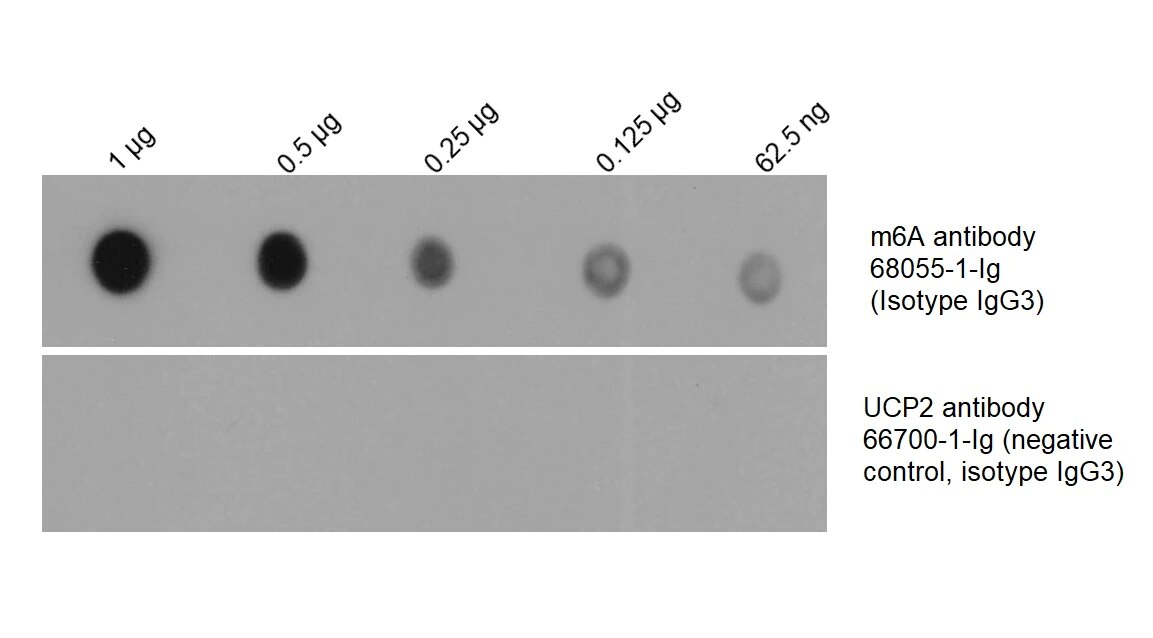New avenue for treatment of ALS and frontotemporal dementia? A canonical m6A reader is a potential new target for ALS and frontotemporal dementia
Author: Michael McMillan PhD, Scientist I at QurAlis. Lead author of “RNA methylation influences TDP43 binding and disease pathogenesis in models of amyotrophic lateral sclerosis and frontotemporal dementia” published in Molecular Cell.
Proteintech has always supported and been highly interested in ALS research. Dr Michael McMillian, a Proteintech customer, used our TDP43 (10782-2-AP) and YTHDF2 (24744-1-AP) antibodies in a recent Molecular Cell paper (PMID: 36634675), for which he is the first author. This highly detailed and insightful paper demonstrates how TDP43 RNA binding capabilities are modified by YTHDF2, a canonical m6A reader, thus highlighting a potential therapeutic target.
Dr McMillan performed this work while at the University of Michigan, under the supervision of Dr Sami Barmada. Now, Dr McMillan works as a Scientist I at QurAlis, and kindly wrote a summary of his fascinating paper.

Graphical abstract from McMilan et al., 2023 Cell.
Could RNA methylation play a role in ALS?
Amyotrophic lateral sclerosis (ALS) is a progressive neurodegenerative disease that, despite recent advancements, still largely remains a mystery mechanistically and has limited therapeutic options. ALS patients can present with different clinical, biochemical, and genetic features, further complicating treatment of the disease. However, in roughly 95% of ALS cases, cytoplasmic inclusions of an RNA binding protein TDP43 (TAR-binding protein of 43 kDa) occur. TDP43 acts as a critical protein for RNA splicing, transport, translation, and stability. Previous data from our lab suggests that TDP43 specifically destabilizes transcripts encoding ribosomal proteins and oxidative phosphorylation enzymes (PMID: 30030424). These same transcripts were also shown to be upregulated when an RNA methyltransferase enzyme related to the RNA modification, N6-methyladenosine (m6A), is knocked down. Evidence supports that TDP43 interacts with other components of the m6A pathway, leading us to hypothesize that TDP43 may be recognizing m6A on RNA transcripts to target certain transcripts.
TDP43 recognizes m6A methylation
Using bioinformatics, we found a slight increase in TDP43 binding motifs upstream of m6A sites, suggesting that TDP43 may be influenced by the presence of m6A modifications. To investigate if TDP43 binds m6A methylated transcripts, we performed DART-seq, a method which allows for detection of m6A sites independent of m6A antibodies, in cells where we endogenously tagged TDP43 with HaloTag to pulldown bound RNA transcripts. The results showed that TDP43-bound transcripts were enriched in m6A compared to controls and showed that there were m6A sites within defined binding regions of its own transcript. Follow up experiments using minigene reporter demonstrated that m6A is crucial for TDP43 RNA substrate recognition.
RNA hypermethylation in ALS spinal cord is regulated by YTHDF2
With this result and our previous evidence implicating m6A in TDPD43 binding, we questioned whether m6A was dysregulated in sporadic ALS (sALS). Using sALS and control spinal cord we performed an m6A array to measure m6A levels in the two groups, finding significant hypermethylation in ALS samples. Since m6A regulation appeared to be disrupted, we utilized CRISPR to knockout components of the m6A pathway in rat neurons to attempt to alleviate effects of TDP43 toxicity. Knocking out writers, erasers, and readers of m6A had varying effects on survival, but only knockout of the m6A reader Ythdf2 reduced TDP43 toxicity. This effect was also observed in human induced pluripotent stem cell (iPSCs) models of ALS, where knockdown of YTHDF2 extended neuronal survival. Conversely, overexpression of YTHDF2 in neurons decreased neuronal survival, and immunostaining in ALS spinal cord displayed a slight increase in YTHDF2 protein compared to control.
Conclusions and implications
These findings implicate m6A dysregulation in disease and potentially identify a source of the RNA instability which is observed in ALS since the main effect of m6A deposition is RNA destabilization. The increased YTHDF2 found in ALS patient spinal cord could be creating cellular toxicity in concordance with mislocalized TDP43, supported by data where YTHDF2 depletion mitigated TDP43 toxicity, extending neuronal lifespan in multiple models of ALS. YTHDF2 has strong associations to RNA degradation, connected to the CCR4-NOT deadenylation complex, ribonuclease P-dependent cleavage, and nonsense mediated decay. The ties to RNA degradation pathways and the data demonstrated in this paper make m6A an exciting new pathway implicated in ALS and YTHDF2 a potential new therapeutic target towards finding treatments for ALS.
Antibodies and related products for m6A modifications
m6A Monoclonal Antibody (68055-1-Ig)
|
|
m6A Writers |
m6A Readers |
m6A Erasers |
Antibodies and products for TDP43
Proteintech’s TDP-43 polyclonal antibody 10782-2-AP played a seminal role in the discovery of this protein (Neuman et al. 2006). Our whole protein immunogen strategy enabled the visualisation of aggregated TDP-43 in more disease scenarios.
Proteintech TDP43 products have over 1500 citations to date, and we have developed a wide range of products to target TDP-43 in a variety of states such as the pathogenic c-terminal fragment and phosphorylated TDP-43.
Antigen Name |
CatalogNo |
Host and Clonality |
Application |
|
TDP-43 |
Rabbit Polyclonal |
FC, IF, IHC, WB, ELISA |
|
|
TDP-43 (C-terminal) |
Rabbit Polyclonal |
IF, IHC, IP, WB, ELISA |
|
|
TDP-43 |
Rabbit Polyclonal |
FC, IF, IHC, IP, WB, ELISA |
|
|
Phospho-TDP43 (Ser409/410) |
Rabbit Polyclonal |
WB, ELISA |
|
|
TDP-43 (human specific) |
Mouse Monoclonal |
FC, IHC, IP, WB, ELISA |
|
|
Phospho-TDP43 (Ser403/404) |
Mouse Monoclonal |
FC, WB, ELISA |
|
|
Phospho-TDP43 (Ser409/410) |
Mouse Monoclonal |
WB, ELISA |
|
|
TDP-43 |
Mouse Monoclonal |
FC, IHC, WB, ELISA |
|
|
TDP-43 (C-terminal) |
Mouse Monoclonal |
FC, IF, IHC, WB, ELISA |
|
|
TDP-43 |
Rabbit Recombinant |
FC, IHC, WB, ELISA |
|
|
TDP-43 (for IF/FC) |
Rabbit Recombinant |
FC, IF, ELISA |
|
|
Phospho-TDP43 (Ser409/410) |
Rabbit Recombinant |
IHC, WB, ELISA |
|
|
TDP-43 |
Rabbit Polyclonal |
FC (Intra), IF |
|
|
TDP-43 (C-terminal) |
Rabbit Polyclonal |
FC (Intra), IF |
|
|
TDP-43 (C-terminal) |
Mouse Monoclonal |
IF |
|
|
TDP-43 (for IF/FC) |
Rabbit Recombinant |
FC (Intra), IF |
|
|
TDP-43 (C-terminal) |
Rabbit Polyclonal |
FC (Intra), IF |
|
|
TDP-43 (C-terminal) |
Mouse Monoclonal |
IF |
|
|
TDP-43 (for IF/FC) |
Rabbit Recombinant |
FC (Intra), IF |
|
|
Human TDP-43 ELISA kit |
Mix |
ELISA (plasma and serum) |
|
|
Human TDP-43 ELISA kit |
Mix |
ELISA (CSF and cell lysate) |
Related Content
Science paper increases understanding of how ALS and frontotemporal dementia pathology interact
7 tips to successfully culture primary rodent Neurons
Introduction to cerebral organoids in research
Support
Newsletter Signup
Stay up-to-date with our latest news and events. New to Proteintech? Get 10% off your first order when you sign up.



